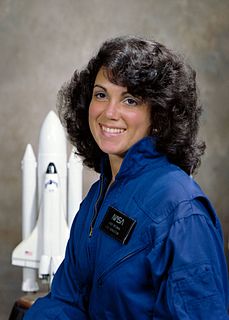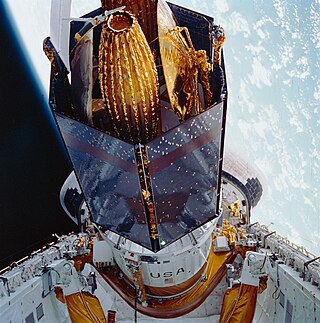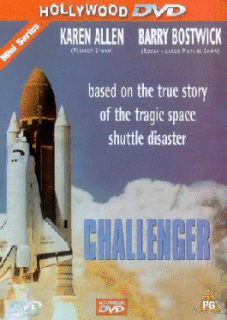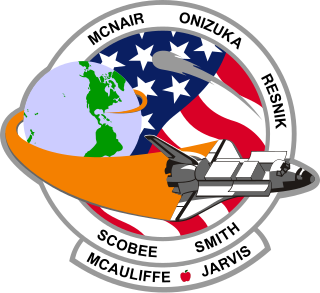
Human spaceflight is spaceflight with a crew or passengers aboard a spacecraft, often with the spacecraft being operated directly by the onboard human crew. Spacecraft can also be remotely operated from ground stations on Earth, or autonomously, without any direct human involvement. People trained for spaceflight are called astronauts, cosmonauts (Russian), or taikonauts (Chinese); and non-professionals are referred to as spaceflight participants or spacefarers.

The Space Shuttle is a retired, partially reusable low Earth orbital spacecraft system operated from 1981 to 2011 by the U.S. National Aeronautics and Space Administration (NASA) as part of the Space Shuttle program. Its official program name was Space Transportation System (STS), taken from a 1969 plan for a system of reusable spacecraft where it was the only item funded for development. The first (STS-1) of four orbital test flights occurred in 1981, leading to operational flights (STS-5) beginning in 1982. Five complete Space Shuttle orbiter vehicles were built and flown on a total of 135 missions from 1981 to 2011, launched from the Kennedy Space Center (KSC) in Florida. Operational missions launched numerous satellites, interplanetary probes, and the Hubble Space Telescope (HST), conducted science experiments in orbit, participated in the Shuttle-Mir program with Russia, and participated in construction and servicing of the International Space Station (ISS). The Space Shuttle fleet's total mission time was 1,323 days.

Gregory Bruce Jarvis was an American engineer and astronaut who died during the destruction of the Space Shuttle Challenger on mission STS-51-L, where he was serving as payload specialist for Hughes Aircraft.

Ellison Shoji Onizuka was an American astronaut, engineer, and USAF test pilot from Kealakekua, Hawaii, who successfully flew into space with the Space Shuttle Discovery on STS-51-C. He died in the destruction of the Space Shuttle Challenger, on which he was serving as Mission Specialist for mission STS-51-L. He was the first Asian American and the first person of Japanese origin to reach space.

Michael John Smith, was an American engineer and astronaut. He served as the pilot of the Space Shuttle Challenger when it was destroyed during the STS-51-L mission, when it broke up 73 seconds into the flight, and at an altitude of 48,000 feet (14.6 km), killing all 7 crew members. Smith's voice was the last one heard on the Challenger voice recorder.

Judith Arlene Resnik was an American electrical engineer, software engineer, biomedical engineer, pilot and NASA astronaut who died in the Space Shuttle Challenger disaster. She was the fourth woman, the second American woman and the first Jewish woman of any nationality to fly in space, logging 145 hours in orbit.

The Space Shuttle Challenger disaster was a fatal accident on January 28, 1986, in the United States space program where the Space ShuttleChallenger (OV-099) broke apart 73 seconds into its flight, killing all seven crew members aboard. It was the first fatal accident involving an American spacecraft in flight. The mission, designated STS-51-L, was the tenth flight for the Challenger orbiter and twenty-fifth flight of the Space Shuttle fleet. The crew was scheduled to deploy a communications satellite and study Halley's Comet while they were in orbit. The spacecraft disintegrated above the Atlantic Ocean, off the coast of Cape Canaveral, Florida, at 11:39 a.m. EST.

STS-41-D was the 12th flight of NASA's Space Shuttle program, and the first mission of Space Shuttle Discovery. It was launched from Kennedy Space Center, Florida, on 30 August 1984, and landed at Edwards Air Force Base, California, on 5 September 1984. Three commercial communications satellites were deployed into orbit during the six-day mission, and a number of scientific experiments were conducted, including a prototype extendable solar array that would eventually form the basis of the main solar arrays on the International Space Station (ISS).

STS-26 was the 26th NASA Space Shuttle mission and the seventh flight of the orbiter Discovery. The mission launched from Kennedy Space Center, Florida, on 29 September 1988, and landed four days later on 3 October 1988. STS-26 was declared the "Return to Flight" mission, being the first mission after the Space Shuttle Challenger disaster of 28 January 1986. It was the first mission since STS-9 to use the original Space Transportation System (STS) numbering system, the first to have all its crew members wear pressure suits for launch and landing since STS-4, and the first mission with bailout capacity since STS-4. STS-26 was also the first U.S. space mission with an all-veteran crew since Apollo 11, with all of its crew members having flown at least one prior mission.

Henry Warren Hartsfield Jr. was a United States Air Force Colonel and NASA astronaut who logged over 480 hours in space. He was inducted into the United States Astronaut Hall of Fame in 2006.

Richard Michael Mullane is an engineer and Weapon Systems Officer, a retired USAF officer, and a former NASA astronaut. During his career, he flew as a mission specialist on STS-41-D, STS-27, and STS-36.

Anna Lee Fisher is an American chemist, emergency physician and a former NASA astronaut. Formerly married to fellow astronaut Bill Fisher, and the mother of two children, in 1984 she became the first mother in space. During her career at NASA, she was involved with three major programs: the Space Shuttle, the International Space Station and the Orion spacecraft.

The Space Mirror Memorial, which forms part of the larger Astronauts Memorial, is a National Memorial on the grounds of the John F. Kennedy Space Center Visitor Complex on Merritt Island, Florida. It is maintained by the Astronauts Memorial Foundation (AMF), whose offices are located in the NASA Center for Space Education next door to the Visitor Complex. The memorial was designed in 1987 by Holt Hinshaw Pfau Jones, and dedicated on May 9, 1991, to remember the lives of the men and women who have died in the various space programs of the United States, particularly those of NASA. The Astronauts Memorial has been designated by the U.S. Congress "as the national memorial to astronauts who die in the line of duty".

STS-51-L was the 25th mission of the NASA Space Shuttle program, the program to carry out routine transportation for Earth-to-orbit crew and cargo; as well as the final flight of Space Shuttle Challenger.

Space Shuttle abort modes were procedures by which the nominal launch of the NASA Space Shuttle could be terminated. A pad abort occurred after ignition of the shuttle's main engines but prior to liftoff. An abort during ascent that would result in the orbiter returning to a runway or to an orbit lower than planned was called an "intact abort", while an abort in which the orbiter would be unable to reach a runway, or any abort involving the failure of more than one main engine, was called a "contingency abort". Crew bailout was still possible in some situations in which the orbiter could not land on a runway.

Challenger is a 1990 American disaster drama television film based on the events surrounding the Space Shuttle Challenger disaster in 1986. Its production was somewhat controversial as the families of the astronauts generally objected to it. A prologue states that the film was "researched with the consultation of the National Aeronauts and Space Administration" and partly filmed at NASA's Johnson Space Center in Houston, Texas.

A payload specialist (PS) was an individual selected and trained by commercial or research organizations for flights of a specific payload on a NASA Space Shuttle mission. People assigned as payload specialists included individuals selected by the research community, a company or consortium flying a commercial payload aboard the spacecraft, and non-NASA astronauts designated by international partners.

The STS-51-L mission started with the ignition of Challenger's main engines until the remote destruction of the two Solid rocket boosters (SRBs), and includes a transcript of crew conversations from the cockpit voice recorder on board the orbiter. STS-51-L was the twenty-fifth flight in the American Space Shuttle program, and marked the first time a civilian had flown aboard the Space Shuttle. The mission used Space Shuttle Challenger, which lifted off from launch pad 39B (LC-39B) on January 28, 1986, from Kennedy Space Center, Florida. The mission ended in disaster following the destruction of Challenger 73 seconds after lift-off, because of the failure of an O-ring seals on Challenger's right solid rocket booster, which led to the rapid disintegration of the Space Shuttle stack from overwhelming aerodynamic pressures. The seven-member crew was killed when the crew compartment hit the Atlantic Ocean at 333 km/h (207 mph), after two and a half minutes of freefall.

NASA Astronaut Group 8 was a group of 35 astronauts announced on January 16, 1978. It was the first NASA selection since Group 6 in 1967, and was the largest group to that date. The class was the first to include female and minority astronauts; of the 35 selected, six were women, one of them being Jewish American, three were African American, and one was Asian American. Due to the long delay between the last Apollo lunar mission in 1972 and the first flight of the Space Shuttle in 1981, few astronauts from the older groups remained, and they were outnumbered by the newcomers, who became known as the Thirty-Five New Guys (TFNG). Since then, a new group of candidates has been selected roughly every two years.

Riding Rockets: The Outrageous Tales of a Space Shuttle Astronaut is a 2006 book by retired astronaut Richard "Mike" Mullane. The book describes Mullane's experiences in the NASA astronaut corps from 1978 to 1990, including his flights on the Space Shuttle and his personal relationships with other astronauts, especially Judy Resnik, who perished in the Challenger accident. The book gives a critical glimpse into the culture of NASA and the astronaut corps. The Publishers Weekly review of the book noted that Mullane "holds female astronauts in special disregard". Kirkus Reviews summarized the book as "one astronaut’s messy, exhilarating story, with no edges sanded off".




















